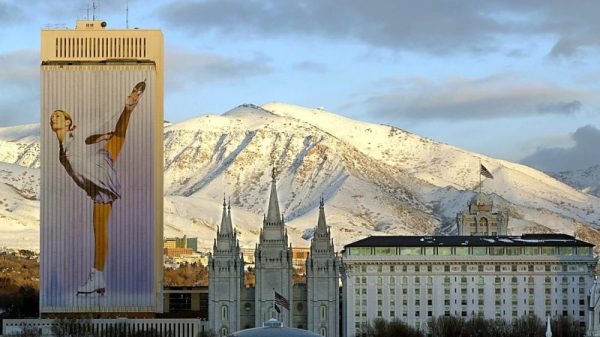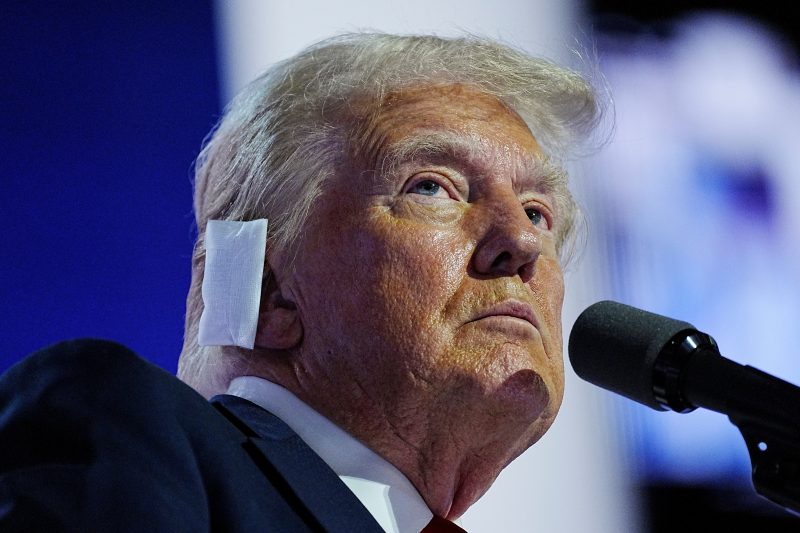Former president Donald Trump’s 92-minute speech accepting the Republican presidential nomination on the final night of his party’s national convention rambled, often incoherently, through a hit parade of his favorite falsehoods, many of them ad-libbed instead of drawn from his prepared remarks. Here are 34 claims that caught our attention, in the order in which he made them. As is our practice, we do not award Pinocchios for a roundup of statements made during convention events.
“When we handed over a stock market that was substantially higher than just prior to covid coming in, did a great job, never got credit for that.”
Trump as president frequently touted the rise of stock prices during his presidency. The S&P 500 index gained about 70 percent during his first term. But it has gone up 50 percent under Biden. Moreover, the record under Barack Obama beat both men.
“The biggest tax cuts ever.”
This is also one of Trump’s favorite falsehoods. Trump’s tax cut amounted to nearly 0.9 percent of the gross domestic product, meaning it was far smaller than President Ronald Reagan’s tax cut in 1981, which was 2.89 percent of GDP.
Trump’s tax cut is the eighth-largest tax cut in the past century — and even smaller than two tax cuts passed under President Barack Obama. Trump’s tax cut was heavily tilted toward the wealthy and corporations.
“The biggest regulation cuts ever.”
Trump’s claim of the most or biggest regulation cuts cannot be easily verified and appears to be false. There is no reliable metric on which to judge this claim — or to compare him with previous presidents. Many experts say the most significant regulatory changes in U.S. history were the deregulation of the airline, rail and trucking industries during the Carter administration, which are estimated to provide consumers with $70 billion in annual benefits. A detailed November 2020 report by the Penn Program on Regulation concluded that “without exception, each major claim we have uncovered by the President or other White House official about regulation turns out to be exaggerated, misleading, or downright untrue.” The report said that the Trump administration had not reduced the overall number of pages from the regulatory code book and that it completed far more regulatory actions than deregulatory ones once the full data set was examined.
“‘Right to Try’ was a big deal. We got Right to Try. They were trying to get that for 52 years.”
Right to Try wasn’t a protracted battle — the idea emerged in 2013. (Trump often falsely claims it was a 45-year or 50-year battle, or as he did here, 52 years.) The initiative allowed for the use of experimental drugs, not approved by the Food and Drug Administration (FDA), as a last resort for those unable to participate in clinical testing who have also exhausted all other treatment options. The FDA had already approved 99 percent of requests for access to unapproved drugs, but supporters thought these policies too restrictive.
“We have an inflation crisis that is making life unaffordable, ravaging the incomes of working and low-income families, and crushing, just simply crushing, our people like never before.”
The monthly inflation headlines are often about the year-over-year inflation rate, as measured by changes in the consumer price index. Inflation reached a high of 9 percent in June 2022. Annualized inflation has dropped significantly since then. The year-over-year figure in June was 3.0 percent — a significant drop.
Inflation initially spiked because of pandemic-related shocks — increased consumer demand as the pandemic eased and an inability to meet this demand because of supply chain issues, as companies had reduced production when consumers hunkered down during the pandemic. Indeed, inflation rose around the world — with many peer countries doing worse than the United States — because of pandemic-related shocks that rippled across the globe.
Wage growth lagged inflation initially in Biden’s term, but it has since caught up. Wages have risen 19.4 percent, compared to cumulative inflation of 19.2 percent. That’s basically treading water, but it’s not as dire as Trump claims.
“I will end the devastating inflation crisis immediately, bring down interest rates, and lower the cost of energy. We will drill, baby, drill.”
Trump has proposed a number of the policies that economists consider to be inflationary, such as a proposal for across-the-board tariffs. (Trump has thrown out a figure of 10 percent, but his staff has said the actual number has not been determined.) Trump has also suggested he would impose a 60 percent tariff on all Chinese goods. While Trump frequently claims tariffs are paid by countries, that’s wrong; the cost of the tariffs generally are passed onto consumers, so it is a form of tax.
The Federal Reserve sets interest rates and Biden has respected its independence, even as it kept interest rates high to keep inflation in check. Cutting interest rates too rapidly could spark inflation.
The Wall Street Journal, in its quarterly survey of forecasters this month, reported “most economists believe inflation, deficits and interest rates would be higher during a second Trump administration than if Biden remains in the White House.”
It also defies economic logic to claim that higher oil production will bring prices down. Domestic oil production and natural gas production are already at record highs under Biden.
“By doing that, we will lead a large-scale decline in prices. Prices will start to come down. Energy raised it.”
Continuing this theme, Trump jumps the shark to claim the solution to inflation is to expand domestic oil production. Energy costs are volatile, and so many economists prefer to focus on what is known as “core inflation” — the price of goods and services excluding energy and food. That’s because energy, like food, is a staple, and demand doesn’t change much no matter the price. People generally need to keep driving cars and eating food. Oil and gas, along with some food products like pork, are also commodities and trade on exchanges, making prices subject to speculation depending on weather, wars and other unforeseen events. Egg prices, in fact, spiked as much as 230 percent in January 2023 because of the bird flu.
“We’ll start paying off debt and start lowering taxes even further.”
Trump often has magical thinking about the national debt. When he first ran for president, Trump confidently claimed that he could eliminate the national debt — then $19 trillion — in just eight years through better trade deals. We gave him Four Pinocchios. He walked back the pledge, saying he would reduce a percentage of the debt. That didn’t happen. Instead, under Trump, the debt climbed to $27.8 trillion from not quite $20 trillion, a gain of $7.9 trillion. (More than half of the debt under Trump came in the last 10 months of his term because of the pandemic.)
Running again for president, Trump now claims the debt would be reduced by money generated by oil and natural gas reserves in the ground. But most of the money is earned by oil producers, not the federal government. The federal government might own some of the land and earn leasing fees. Such fees on U.S. federal lands, federal waters and Native American lands amounted to about $20 billion in fiscal 2022, according to CRFB. The government also earns fees from taxes on sales, with a substantial portion already dedicated to transportation projects. All told, the federal government earns about $100 billion a year from fees and taxes on fossil fuel, according to a 2022 report from Resources for the Future, a nonprofit research group.
The United States had a budget deficit almost four times as high — $383 billion — just in the first two months of fiscal 2024 (which began Oct. 1), showing the folly of Trump’s logic.
“People don’t realize I brought taxes way down, way, way down. And yet we took in more revenues the following year than we did when the tax rate was much higher.”
This is poppycock. Before the pandemic, government revenue under Trump was always supposed to go up year after year, despite the tax cut. That’s because the tax cut merely slowed the growth of revenue, it did not reduce it. As predicted by congressional budget analysts, revenue went way down from what had been anticipated before Congress approved Trump’s tax cut, which (along with higher spending) was the reason the federal budget deficit soared despite a good economy — when ordinarily that would mean a reduced budget deficit
“I will end every single international crisis that the current administration has created, including the horrible war with Russia and Ukraine, which would have never happened if I was president and the war caused by the attack on Israel, which would have never happened if I was president.”
There is no evidence that the invasion of Ukraine or the Hamas attack on Israel would not have happened if Trump had been president. In fact, before Russia’s invasion of Ukraine in February 2022, Trump called Russian president Vladimir Putin a “genius” and “very savvy” for advancing on Ukraine.
“You got to say, that’s pretty savvy,” Trump said on a conservative talk radio show of Putin’s decision to declare certain breakaway regions in Ukraine as independent. “And you know what the response was from Biden? There was no response. They didn’t have one for that. No, it’s very sad. Very sad.” “This is genius,” Trump said. “Putin declares a big portion of the Ukraine … Putin declares it as independent. Oh, that’s wonderful.”
Trump, in his speech, suggested that Iran funded the attack by Hamas but a link has not been established.
“They were ready to make a deal. Iran was going to make a deal with us.”
There is no evidence this is the case. Trump has sometimes claimed that Iran personally warned him they would attack a U.S. base and deliberately miss it. In reality, a vague warning without a target was given to the Iraqi president — and most of the missiles hit the base. No one was killed, but that was more a result of a well-planned evacuation than Iranian targeting. Despite no fatalities, many soldiers suffered serious brain injuries.
“They [Democrats] used covid to cheat [in the election] and [we’re] never going to let it happen again.”
More than sixty lawsuits were filed over the 2020 election, but not a single court identified fraud.
“Now Iran is very close to having a nuclear weapon, which would have never happened.”
Trump pulled out of an international nuclear agreement restraining Iran’s nuclear ambitions that had been negotiated over many years. European allies rejected Trump’s efforts to dismantle the deal and Iran ramped up its nuclear efforts. Biden tried to resurrect the deal, but could not bring Iran back to the negotiating table.
“Just a few short years ago under my presidency, we had the most secure border [in the history of our country].”
Annual apprehensions at the southwest border totaled 310,531 in fiscal year 2017, which included part of the Obama administration, and that was the lowest since 1971. But then the numbers spiked in Trump’s term, reaching 859,501 in fiscal year 2019, the highest since 2009. Apprehensions plunged in April 2020 because of lockdowns at the start of the pandemic.
“We had the greatest economy in the history of the world”
One of Trump’s favorite falsehoods is that he created the greatest economy in U.S. history, but he amps it here to encompass the whole world. That’s ridiculous.
Before the coronavirus pandemic shuttered businesses and sent unemployment soaring, the president could certainly brag about the state of the economy in his first three years as president. But he ran into trouble when he made a play for the history books to say it was the best economy ever.
By just about any important measure, the economy under Trump did not do as well as it did under Presidents Harry S. Truman, Lyndon B. Johnson and Bill Clinton. The gross domestic product grew at an annual rate of 2.3 percent in 2019, slipping from 2.9 percent in 2018 and 2.4 percent in 2017. But in 1997, 1998 and 1999, GDP grew 4.5 percent, 4.5 percent and 4.7 percent, respectively. Yet even that period paled in comparison with the 1950s and 1960s. Growth between 1962 and 1966 ranged from 4.4 percent to 6.6 percent. In postwar 1950 and 1951, it was 8.7 percent and 8 percent, respectively.
The unemployment rate reached a low of 3.5 percent under Trump, but for several months in 2023, the unemployment rate under Biden fell to as low as 3.4 percent. The unemployment rate dipped as low as 2.5 percent in 1953.
“We had no inflation.”
There was inflation under Trump — about 1.9 percent a year. That was pretty good but it was 1.4 percent a year under Obama.
“We’ve suffered the worst inflation we’ve ever had.”
Inflation under Biden has been the highest in four decades, but 9 percent is not the worst in history. It was 18 percent in 1946, more than 12 percent in 1974, more than 13 percent in 1979 and 12.5 percent in 1980. Many other years were at or near 9 percent.
“Our cities are flooded with illegal aliens. Americans are being squeezed out of the labor force and their jobs are taken. And by the way, you know who’s taking the jobs? The jobs that are created, 107 percent of those jobs are taken by illegal aliens.”
Trump falsely says that undocumented immigrants are taking jobs from U.S. citizens. Employment for the native-born population has increased by more than 7.2 million under Biden, according to the Bureau of Labor Statistics. (We start from February 2021, the first full month that reflects employment under Biden.)
Meanwhile, employment of foreign-born workers increased about 5 million from February 2021 through June, BLS says. The agency says this figure includes more than just undocumented immigrants; it also includes legally admitted immigrants, refugees and temporary residents such as students and temporary workers.
“Under this administration, groceries are up 57 percent, gasoline is up 60 and 70 percent. Mortgage rates have quadrupled.”
These numbers are inflated. Food prices overall have risen 21.4 percent since Biden took office, according to the Bureau of Labor Statistics data that measures inflation for dairy products, meats, and fruits and vegetables.
As for gasoline, the price of crude oil was unusually low when Trump was in office because the coronavirus pandemic flattened economies around the world. After mass vaccination helped reopen many economies, demand increased again. But supply was lacking because oil producers decreased their production levels.
The retail price of gasoline was $2.64 a gallon in January 2021 when Trump left office. The price of regular gasoline now averages $3.52 a gallon, according to AAA. That’s an increase of 33 percent. (On an inflation-adjusted basis, gasoline now is slightly higher than the average of $3.20 over the last 106 years.)
As for mortgage rates, that is the result of Federal Reserve policy designed to tamp down inflation. But they did not quadruple. The average 30-year rate was 2.96 percent in 2021 and now is about 7 percent.
“We have more liquid gold under our feet than any other country by far. We are a nation that has the opportunity to make an absolute fortune with its energy.”
This is false. According to the Energy Information Administration, the United States has proven crude oil reserves of 44 billion barrels, which would put the country in 10th place. Venezuela, with 304 billion barrels of oil reserves, is in first place, followed by Saudi Arabia (259 billion), Iran (209 billion), Canada (170 billion) and Iraq (145 billion). The United States ranks fourth in the world in natural gas reserves.
“Under the Trump administration, just three and a half years ago, we were energy independent.”
Trump claims the United States energy independent because it exported more crude and refined products than it imported. (The United States still relied on other countries for its energy needs.) The situation has not changed under Biden. In 2023, the United States imported about 8.51 million barrels per day of petroleum and exported about 10.15 million barrels per day, according to the Energy Information Administration, making the United States still a net exporter.
“This is the only administration that said we’re going to raise your taxes by four times what you’re paying now.”
This is false. For five years, Biden has been consistent in saying he will not raise taxes on people making less than $400,000 a year, which leaves about the top 2 percent of taxpayers. Biden reiterated this pledge in the budget plan he released earlier this year.
“I will end the electric vehicle mandate on day one, thereby saving the U.S. auto industry from complete obliteration, which is happening right now.”
In April, the Environmental Protection Agency issued a regulation designed to promote a transition to more electric vehicles — part of a worldwide trend. The European Union, for instance, has mandated the sale of only zero-emission new cars by 2035.
There is no evidence that electric vehicles will lead to the end of the auto industry. Automakers have invested billions of dollars in electric-vehicle and battery manufacturing. A report issued by the Environmental Defense Fund in August said $93 billion of announced EV investments and nearly 85,000 in announced jobs took place in the 12 months after passage of the Inflation Reduction Act. In a December research report, Goldman Sachs said that as a result of the Inflation Reduction Act, the United States could be self-sufficient in EV battery production — including mining, components and battery production — by 2030.
“I got rid of NAFTA, the worst trade deal ever made, and replaced it with USMCA, which is, they say, the best trade deal ever made.”
Trump falsely suggests he significantly overhauled the North American Free Trade Agreement (NAFTA) when he replaced it with USMCA. But the new agreement only made modest tweaks to NAFTA, such as modernizing trade rules in effect from 1994 to 2020, giving some wins to U.S. farmers and blue-collar workers in the auto sector. Some elements of the deal were borrowed from the Trans Pacific Partnership, the trade deal Trump scrapped at the start of his term. The U.S. International Trade Commission, which is tasked with evaluating the impact of trade agreements, calculated USMCA would have a relatively minor impact: The USMCA would raise U.S. real gross domestic product by $68.2 billion (0.35 percent) and U.S. employment by 176,000 jobs (0.12 percent).
As for NAFTA being the worst deal ever made, the nonpartisan Congressional Research Service in 2017 concluded that the “net overall effect of the North American Free Trade Agreement on the U.S. economy appears to have been relatively modest, primarily because trade with Canada and Mexico accounts for a small percentage of U.S. GDP,” though it noted that “there were worker and firm adjustment costs as the three countries adjusted to more open trade and investment among their economies.”
“If you go back 20, 25 years, they’ve stolen, going to China and Mexico, about 68 percent of our auto industry manufacturing jobs.”
It’s unclear where Trump gets this figure; as president he would claim the number was 32 percent, but his administration never produced a source. Millions of manufacturing jobs and thousands of U.S. manufacturing establishments have disappeared since NAFTA took effect in 1994, but it’s difficult to isolate how much of that was because of NAFTA and not other factors, such as automation. The studies we reviewed indicate NAFTA had a modest effect on the U.S. economy.
“They’ve just hired, as you know, 88,000 [IRS] agents to go after them even more.”
Trump made this comment after he recounted a story about a waitress complaining about being taxed on her tips. This 88,000 figure is wildly exaggerated. The IRS employees have not yet all been hired and they are not all agents.
When Congress passed a bill to provide the IRS with an additional $80 billion in funding over 10 years, that money was to be used in part to hire 86,852 full-time employees in the next decade. But many of those employees would not be enforcement “agents” but people hired to improve information technology and customer service.
Treasury officials say that because of attrition, after 10 years of increasing spending, the size of the agency will have grown only 25 to 30 percent when the hiring burst is complete. The administration’s strategic plan for the IRS estimated that an additional 1,543 full-time employees would be hired for enforcement in 2023, or about 15 percent of newly hired staff. That would grow to 7,239 in 2024, or 37 percent of new staff. Biden administration officials have pledged that enforcement efforts to collect unpaid taxes will concentrate on those earning more than $400,000.
“I’m going to protect Social Security and Medicare. Democrats are going to destroy Social Security and Medicare because all of these people, by the millions, they’re coming in.”
This is false. Undocumented immigrants improve the health of Social Security and Medicare by paying payroll taxes without receiving benefits. In a fact check, we calculated the figure for Social Security payments made by undocumented immigrants is now about $27 billion. For Medicare, it should be at least $6 billion, as the Medicare tax is about 23 percent of the Social Security tax.
“The other countries weren’t accepting them back. And I called up and I said, tell them that we’re not giving them economic aid anymore.”
Trump told a long story about how he convinced countries that were not accepting the deportation gang members. He specifically mentioned MS-13, a transnational gang that formed in Los Angeles in the 1980s among members of the Salvadoran community who had fled violence and civil conflict in El Salvador. But he suggested the countries would not accept these gang members until he threatened to withhold aid. In his retelling, he claimed one official called him “sir” — usually a sign that Trump is telling a fable.
In reality, the United States deported hundreds of thousands of immigrants from Guatemala, Honduras and El Salvador years before Trump took office. From 2013 to 2018, such deportations totaled 550,186. In fact, the Obama administration prioritized the deportations of gang members and individuals with criminal records. Trump, upon taking office, scrapped that priority list and allowed officials to prioritize nonviolent immigration offenders over violent ones.
“They’re coming from everywhere. They’re coming at levels that we’ve never seen before. It is an invasion, indeed. And this administration does absolutely nothing to stop them. They’re coming from prisons, they’re coming from jails. They’re coming from mental institutions and insane asylums.”
This is fantasy. Immigration experts know of no such effort by other countries.
As someone who came to prominence in the late ’70s and early ’80s, Trump appears to be channeling Cuban leader Fidel Castro’s 1980 Mariel boatlift. About 125,000 Cubans were allowed to flee to the United States in 1,700 boats — but there was a backlash when it was discovered that hundreds of refugees had been released from jails and mental health facilities.
Helen Fair, research associate at the Institute for Crime & Justice Policy Research in Britain, which tracks the world prison population (except for a handful of countries), says the numbers keep growing. In 2013, 10.2 million people were in prison — and that had grown to 10.77 million in 2021. A preliminary estimate for February 2024, not ready to be published, indicates the population has grown even more. “In short, I would disagree with Donald Trump’s assertion,” she said.
“Meanwhile, our crime rate is going up.”
This is false. Violent crime rates, especially for homicide in large cities, have fallen sharply during Biden’s presidency, after a surge during the pandemic. The violent crime rate is believed to be near its lowest level in 50 years.
“In Venezuela, Caracas. High crime, high crime. Caracas, Venezuela. Really a dangerous place, but not anymore. Because in Venezuela, crime is down 72 percent.”
There is no reliable data on crime in Venezuela — the government stopped publishing official data in 2015 — so it’s unclear where Trump gets this number. But it’s higher than what even the government says. In May, Venezuelan security officials announced that crime indicators had fallen by 25.1 percent compared to 2023, claiming that security forces had been successful in large-scale operations against criminal groups. Some experts believe the impossible-to-verify numbers are intended to boost the sagging popularity of the Nicolás Maduro government.
“We defeated 100 percent of ISIS in Syria and Iraq, something that was said to take five years. ‘Sir, it will take five years, sir.’ We did it in a matter of a couple of months.”
It took the United States and coalition partners more than two years to defeat the Islamic State (ISIS) after Trump took office. In fact, President Barack Obama set up virtually all the structure that did the key fighting against the Islamic State under Trump, and more fighters were trained and munitions dropped under Obama than under Trump.
Under Obama, all Iraqi cities held by ISIS (with the exception of the western half of Mosul) — such as eastern Mosul, Fallujah, Ramadi and Tikrit — were retaken by the end of his term, as was much of the northeastern strip of Syria along the Turkish border. The basic plan of attack in 2017 was also developed under Obama, though Trump sped up the tempo by changing the rules of engagement.
As for “100 percent,” that’s exaggerated. The loss of physical territory did not mean the group was defeated. In August 2019, the Defense Department inspector general warned: “Despite losing its territorial ‘caliphate,’ the Islamic State … solidified its insurgent capabilities in Iraq and was resurging in Syria. The reduction of U.S. forces has decreased the support available for Syrian partner forces at a time when their forces need more training and equipping to respond to the ISIS resurgence.”
“It began to unravel with the disastrous withdrawal from Afghanistan, the worst humiliation in the history of our country.”
Biden essentially adhered to the timeline of withdrawal of troops from Afghanistan negotiated by Trump. The outcome might not have been much different if Trump had been reelected and was serving a second term at the time.
In March 2020, Trump approved an agreement with the Taliban (not the Afghan government) for U.S. forces to leave the country by May 2021. Despite abandoning many of Trump’s policies, President Biden decided to stick with this one, just stretching out the departure by a few months.
Trump originally celebrated Biden’s decision to stick with his original plan. “Getting out of Afghanistan is a wonderful and positive thing to do. I planned to withdraw on May 1st, and we should keep as close to that schedule as possible,” he said in a written statement after Biden announced he would continue the departure set in motion by Trump.
At a political rally on June 26, weeks before the collapse of the Afghan government, Trump bragged that he had made it difficult for Biden to change course. “I started the process. All the troops are coming back home. They couldn’t stop the process,” he said. “Twenty-one years is enough, don’t we think? Twenty-one years. They [the Biden administration] couldn’t stop the process. They wanted to, but it was very tough to stop the process.”
Trump’s tone changed after the Afghan military crumbled faster than intelligence officials predicted.
“We also left behind [in Afghanistan] $85 billion worth of military equipment.”
This is a highly inflated number for which we have previously awarded Trump Three Pinocchios. It’s not invented out of whole cloth. But it reflects all the money spent to train, equip and house the Afghan military and police — so weapons are just a part of that. U.S. military equipment was given to Afghan security forces over two decades. Tanks, vehicles, helicopters and other gear fell into the hands of the Taliban when the U.S.-trained force quickly collapsed. In 2022, CNN reported that a Defense Department report estimated that $7 billion of military equipment had been left behind.
(About our rating scale)
Send us facts to check by filling out this form
Sign up for The Fact Checker weekly newsletter
The Fact Checker is a verified signatory to the International Fact-Checking Network code of principles



























